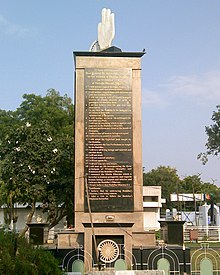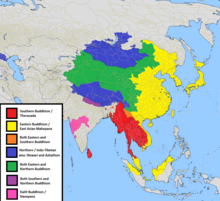Navayana (Devanagari: नवयान, IAST: Navayāna) means “new vehicle” and refers to the re-interpretation of Buddhism by Bhimrao Ramji Ambedkar;[a] it is also called Neo-Buddhism,[1][2] and Bhimayāna (after Ambedkar’s first name, Bhimrao).[3] Ambedkar was born in a Dalit (untouchable) family during the colonial era of India, studied abroad, became a Mahar Dalit leader, and announced in 1935 his intent to convert from Hinduism to Buddhism.[4] Thereafter Ambedkar studied texts of Buddhism, found several of its core beliefs and doctrines such as Four Noble Truths and “non-self” as flawed and pessimistic, then re-interpreted these into what he called “new vehicle” Buddhism, or Navayana.[3] Ambedkar held a press conference on 13 October 1956, announcing his rejection of Theravada and Mahayana Buddhism, as well as of Hinduism.[5] Thereafter, he left Hinduism and adopted Navayana, about six weeks before his death.[1][3][5] Its adherents see Navayana Buddhism not as a sect with radically different ideas, but rather as new movement founded on the principles of Buddhism.
In the Dalit Buddhist movement of India, Navayana is considered a new branch of Buddhism, different from the traditionally recognized branches of Theravada, Mahayana, and Vajrayana[6] – considered to be foundational in the Buddhist traditions.[7][b] It radically re-interprets what Buddhism is,[8][c] revising the original Buddha teaching to be about class struggle and social equality.[3][9][10]
Ambedkar called his version of Buddhism Navayana or “Neo-Buddhism”.[11] His book, The Buddha and His Dhamma is the holy book of Navayana followers. Followers of Navayana Buddhism are generally called “Buddhists” (Baud’dha) as well as Ambedkarite Buddhists, Neo-Buddhists, and rarely Navayana Buddhists.[12]
While the term Navayana is most commonly used in reference to the movement Ambedkar founded in India, it is also (more rarely) used in a different sense, to refer to Westernised forms of Buddhism.
Origins

Buddhist flag of Navayana Buddhists
Ambedkar was an Indian leader influential during the colonial era and the early post-independence period of India. He was the fourteenth child in an impoverished Maharashtra Dalit family, who studied abroad, returned to India in the 1920s and joined the political movement. His focus was social and political rights for the Dalits.[14] To free his community from religious prejudice, he concluded that they must leave Hinduism and convert to a different religion. He chose Buddhism in the form of Navayana.[14][9]
Doctrines and concepts
In 1935, during his disagreements with Mahatma Gandhi, Ambedkar announced his intent to convert from Hinduism to Buddhism.[4] Over the next two decades, Ambedkar studied texts of Buddhism and wrote his text, The Buddha and His Dhamma, which is the primary doctrine of those who follow Navayana Buddhism.[15]
Core beliefs
In his unpublished editorial of the founding text of the Navayana, Ambedkar writes:
To disarm all criticism I would like to make it clear that I claim no originality for the book. It is a compilation and assembly plant. The material has been gathered from various books. I would particularly like to mention Ashvaghosha’s Buddhavita, whose poetry no one can excel. In the narrative of certain events I have even borrowed his language.[16]
This indicates that Navayana Buddhism is not a sect with radically different ideas, but a new movement from the same principles of Buddhism.
He goes on further to say that his doctrine simplifies the teachings of Buddhism and clear up the various misconceptions and possible points of confusion people may have about the faith. He explains
The only originality that I can claim in is the order of presentation of the topics, in which I have tried to introduce simplicity and clarity. There are certain matters which give headaches to the student of Buddhism.[citation needed]
Buddhism’s place within modernism and science
In his essay, Buddha and the Future of His Religion, Ambedkar mentions that the only major faith compatible with science is Buddhism. He compares Jesus, the Prophet Muhammed, and Krishna to the Buddha, and mentions that while Jesus called himself the “son of god”, the prophet Muhammad called himself the “messenger of god”, and Krishna called himself the “god of gods” (Parameswhar), Buddha was
born as a son of man and was content to remain a common man and preached his gospel as a common man. He never claimed any supernatural origin or supernatural powers, nor did he perform miracles to prove his supernatural powers.[17]
In addition, he states, that Buddhism is one of the few religions that do not claim their values are derived from a god, and are therefore innately flexible and capable of withstanding Modernism. Ambedkar writes in the same essay:
[T]he Buddha claimed no such infallibility for what he taught. In the Mahaparinibbana Sutta he told Ananda that his religion was based on reason and experience and that his followers should not accept his teaching as correct and binding merely because they emanated from him. Being based on reason and experience they were free to modify or even to abandon any of his teachings, if it was found that at a given time and in given circumstances they do not apply.[citation needed]
Buddhist karma and its misrepresentation by Hindus
One of the major misunderstandings that Ambedkar sought to clear about Buddhism was that of karma and anatta, and a seeming contradiction between the principles. Based on this, many believed Buddhism is very similar to Hinduism on the account of there being karma and rebirth in both faiths. On this, Ambedkar made it very clear that these are very different philosophies:
Ignorant Hindus, out of sheer want of understanding, say by comparing merely the similarity of words, that Buddhism is the same as Brahmanism or Hinduism … The Hindu Law of Karma is based on the soul. The Buddhist [karma] is not. In fact, there is no soul in Buddhism.[citation needed][d]
Therefore, he reasons, the karma in Buddhism is a moral philosophy based only on actions of one’s immediate life, such that an individual is not rendered helpless. He argues that a karma based on previous life is a dangerous ideology, because
for in this interpretation of karma there is no room left for human effort. Everything is predetermined for him by his past karma.
He also claims that inherited karma is a blatantly anti-scientific concept, arguing that
According to science, a child inherits the characteristics of his parents. In the Hindu doctrine of karma, a child inherits nothing from its parents except the body. The past karma in the Hindu doctrine is the inheritance of the child by the child and for the child. The parents contributes nothing. The child brings everything. Such a doctrine is nothing short of an absurdity. As shown above, the Buddha did not believe in such an absurdity.[18]
Ambedkar’s 22 vows

Inscription of 22 vows at Deekshabhoomi, Nagpur
The Twenty-two vows or twenty-two pledges are the 22 Buddhist vows administered by B. R. Ambedkar, the revivalist of Buddhism in India, to his followers. On converting to Buddhism, Ambedkar made 22 vows, and asked his 600,000 supporters to do the same.[19] After receiving lay ordination, Ambedkar gave dhamma diksha to his followers. The ceremony included 22 vows administered to all new converts after Three Jewels and Five Precepts. On 14 October 1956 at Nagpur, Ambedkar performed another mass religious conversion ceremony at Chandrapur.[20][21]
It is believed by Ambedkarite Buddhists that these vows are the guidelines of the social revolution that motivates human instincts. These vows demonstrate both the social movement aspect of Navayana Buddhism, and demonstrate its core deviation from earlier sects of Buddhism. In India, these vows are taken as an oath by individuals or groups of people when they convert to Buddhism.[22][23]
Commencement

Ambedkar delivering a speech during mass conversion in Nagpur, 14 October 1956.
Ambedkar re-interpreted Buddhism to address such issues in his mind, and re-formulated the traditional teachings of Buddhism into a “new vehicle” called Navayana.[1][3] Navayana dhamma doctrine as propounded by Ambedkar, states Sumant (2004),[24] “does not situate morality in a transcendental [religious] domain”, nor in “a civil association, including the state”. Dhamma is derived from and the guiding principle for social conscience.[24]
Navayana Buddhism began in 1956, when Bhimrao R. Ambedkar adopted it, and 380,000 Dalit community members converted to Navayana from Hinduism on 14 and 15 October 1956.[14][5] After that on every year 14 October is celebrated as Dhammachakra Pravartan Day at Dikshabhoomi, Nagpur:
I will accept and follow the teachings of Buddha. I will keep my people away from the different opinions of Hinayana and Mahayana, two religious orders. Our Buddhism is a Neo-Buddhism, Navayana. — B.R. Ambedkar[25]
Scripture and practice
The writings of B.R. Ambedkar were posthumously published as The Buddha and His Dhamma, and this is the scripture for those who follow Navayana Buddhism.[26] Among Navayana followers, state Keown & Prebish (2013),[9] this is “often referred to as their ‘bible’ and its novel interpretation of the Buddhist path commonly constitutes their only source of knowledge on the subject”.[9]
B.R. Ambedkar is regarded as a bodhisattva, the Maitreya, among the Navayana followers.[27][28] In practice, the Navayana followers revere Ambedkar, states Deitrick (2013),[29] as virtually on-par with the Buddha.[29] He is considered as the one prophesied to appear and teach the dhamma after it was forgotten; his iconography is a part of Navayana shrines and he is shown with a halo.[28] Though Ambedkar states Navayana to be atheist, Navayana viharas and shrines features images of the Buddha and Ambedkar, and the followers bow and offer prayers before them in practice.[30] According to Junghare (1988),[31] for the followers of Navayana, Ambedkar has become a deity and is devotionally worshipped.[31][e]
Reception
B. R. Ambedkar’s re-interpretation of Buddhism and his formulation of Navayana has attracted admirers and criticism.[10] The Navayana theories restate the core doctrines of Buddhism, according to Zelliot & Macy (1980),[32] wherein Ambedkar’s “social emphasis exclude[s] or distort some teaching, fundamental to traditional and canonical Buddhism”.[32] Anne Blackburn states that Ambedkar re‑interprets core concepts of Buddhism in class conflict terms, where nirvana is not the aim and end of spiritual pursuits, but a preparation for social action against inequality:
Ambedkar understands the Buddha’s teaching that everything is characterized by Dukkha, or unsatisfactoriness, as referring specifically to interpersonal relations. In one instance Ambedkar presents a dialogue in which the Buddha teaches that the root of dukkha is class conflict and asserts elsewhere that “the Buddha’s conception of Dukkha is material”. — A. Blackburn[10]
Nibbana (Skt. nirvana) the state or process which describes enlightenment, is considered [by Ambedkar] a precursor for moral action in the world and explicitly associated with a non-monastic lifestyle. Nibbana “means enough control over passion so as to enable one to walk on the path of righteousness”. Ambedkar’s interpretation of dukkha and nibbana implies that moral action, for which nibbana is preparation, will rectify the material suffering of inequality.[10]
Ambedkar considered all ideas in Theravada and Mahayana Buddhism that relate to an individual’s merit and spiritual development as insertions into Buddhism, and something that “cannot be accepted to be the word of the Buddha”. Buddhism, to Ambedkar, must have been a social reform movement.[10][32] Martin Fuchs states that Ambedkar’s effort is to be admired as an attempt to seek a “post-religious religion” which transcends distinctions and as being driven by the “reasonable principle of sociality”, not in the sense of spiritual doctrines, philosophical speculations and existentialist questions.[33]
According to Blackburn, “neither view of traditional Buddhism — as a social reform movement or as some other stable entity interpreted (or misinterpreted) from a social reform perspective — is historically accurate”, thereby placing Navayana theories to be a‑historical, though it served as an important means to Dalit political mobilization and social movement.[10]
Scholars broadly accept that the depictions of the Buddha as a caste or social reformer are inaccurate.[10][34][f] Gombrich (2012),[35] states that there is no evidence that the Buddha began or pursued social reforms, or was against a caste system, rather his aim was at the salvation of those who joined his monastic order.[35][36][37] Modernist interpreters of Buddhism, states Gombrich, keep picking up this “mistake from western authors”, a view that initially came into vogue during the colonial era.[35][38][39] Empirical evidence outside of India, such as in the Theravada Buddhist monasteries of the Sinhalese society, suggests that caste ideas have been prevalent among the sangha monks, and between the Buddhist monks and the laity. In all canonical Buddhist texts, the kshatriyas (warrior caste) are always mentioned first and never other classes such as brahmins, vaishyas, shudras or the untouchables.[40]
The novel interpretations and the dismissal of mainstream doctrines of Buddhism by Ambedkar as he formulated Navayana has led some to suggest that Navayana may more properly be called Ambedkarism.[9] However, Ambedkar did not consider himself as the originator of a new Buddhism, but stated that he was merely reviving what was original Buddhism after centuries of “misguided interpretation” by wrong headed Buddhist monks.[9] Others, states Skaria, consider Ambedkar attempting a synthesis of the ideas of modern Karl Marx into the structure of ideas by the ancient Buddha, as Ambedkar worked on essays on both in the final years of his life.[41]
According to Janet Contursi, Ambedkar re-interprets Buddhist religion and with Navayana “speaks through Gautama and politicizes the Buddha philosophy as he theologizes his own political views”.[42]
Status in India

Map showing major Buddhist divisions, Navayana in pink.

District wise Buddhist population percentage, India census 2011. India’s West-centre area Maharashtra shows Navayana Marathi Buddhist population
According to the 2011 Census of India there are 8.4 million Buddhists in India. Navayana Buddhists comprise about 87% (7.3 million) of Indian Buddhist community, and nearly 90% (6.5 million) of all Navayana Buddhists in India live in Maharashtra state.[43][44] A 2017 IndiaSpend.com report on census data says “Buddhists have a literacy rate of 81.29%, higher than the national average of 72.98%”, but it does not distinguish Navayana Buddhists from other Buddhists.[43] When compared to overall literacy rate of Maharashtra state where 80% of Buddhists are found, their literacy rate is 83.17% or slightly higher than statewide average of 82.34%.[43]
According to Jean Darian, the conversion to Buddhism and its growth in India has in part been because of non-religious factors, in particular the political and economic needs of the community as well as the needs of the political leaders and the expanding administrative structure in India.[45] According to Trevor Ling and Steven Axelrod, the intellectual and political side of Navayana Buddhist movement lost traction after the death of Ambedkar.

Greetings! This is my first visit to your blog! We are a team of volunteers and starting a new initiative in a community in the same niche. Your blog provided us beneficial information to work on. You have done a outstanding job!|
Thanks very nice blog!|